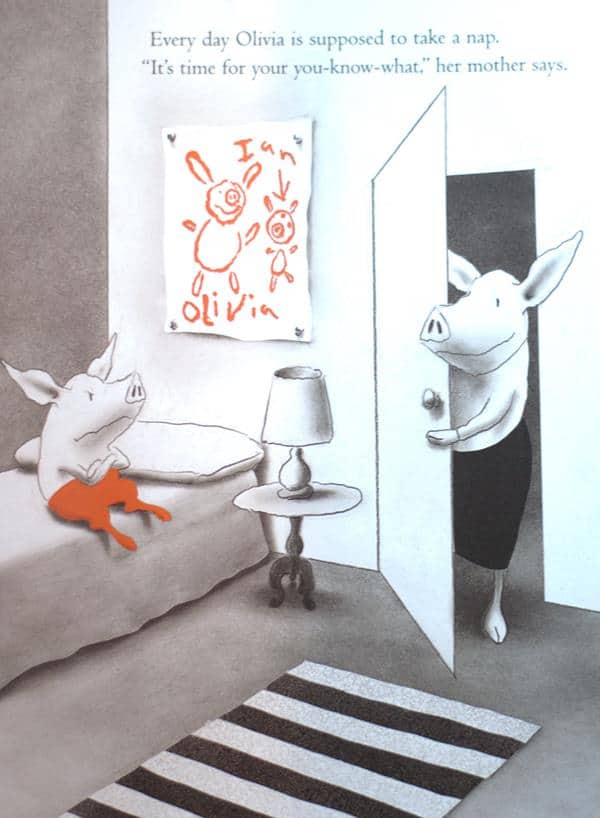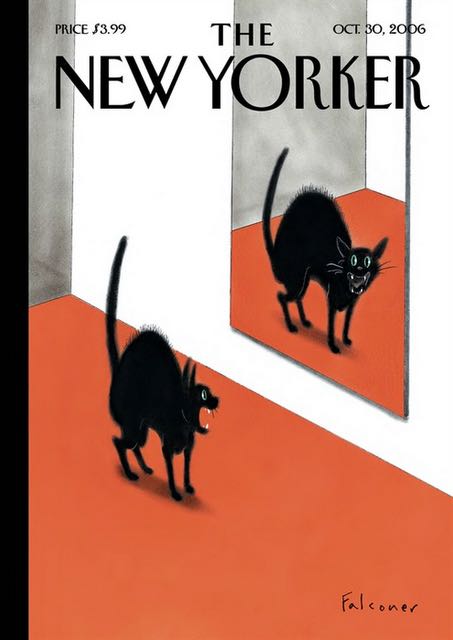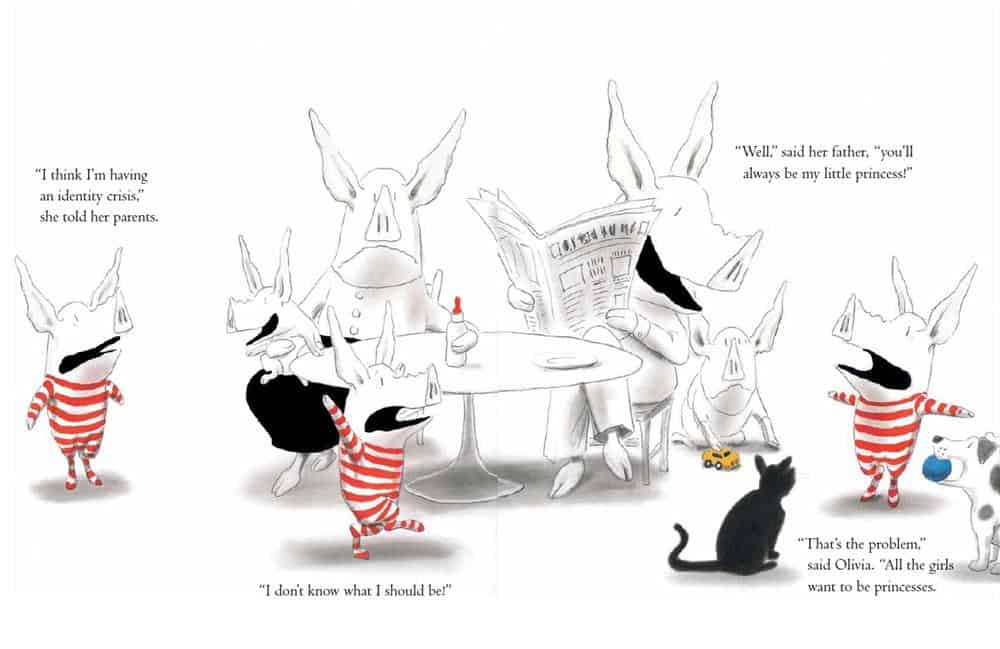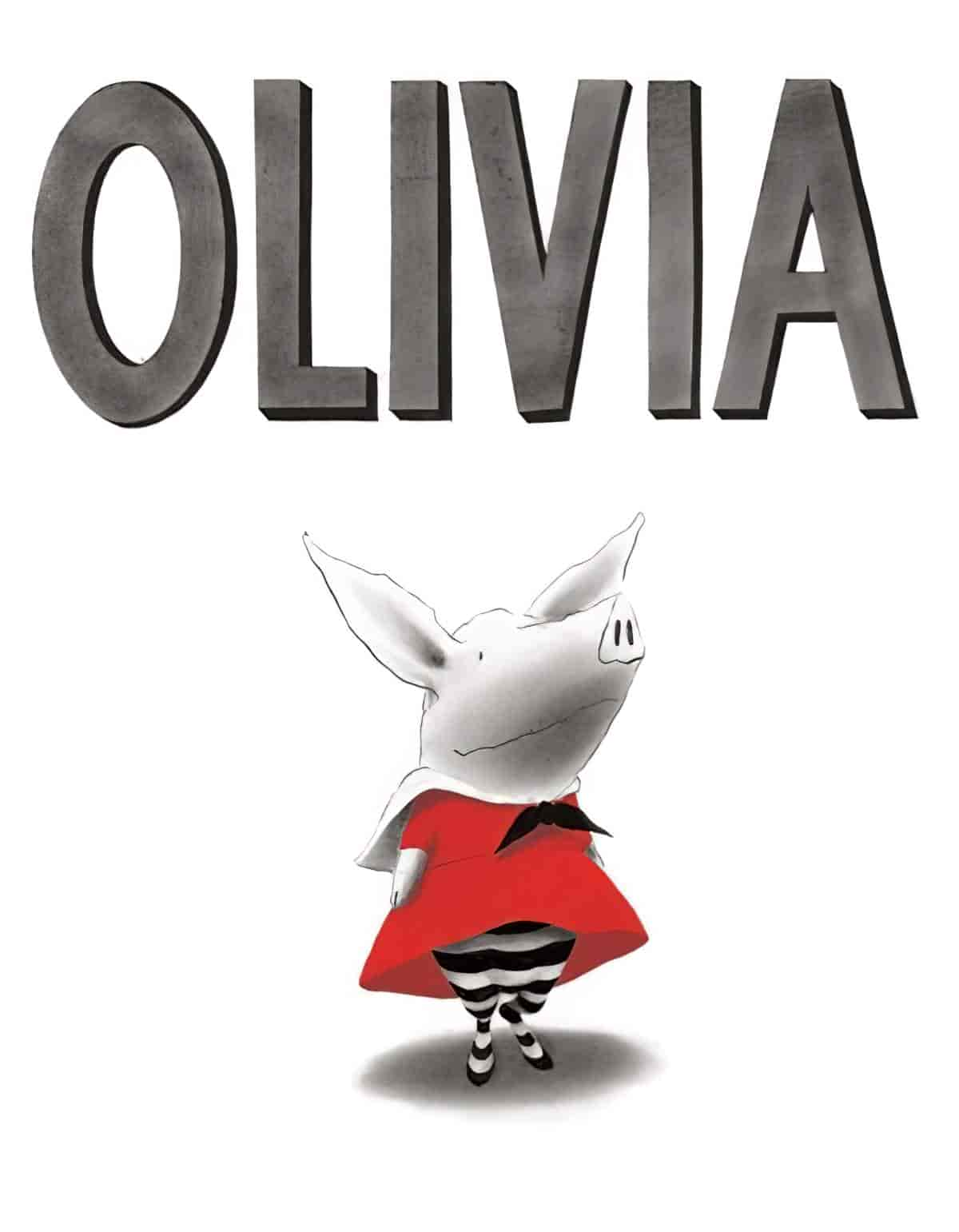Starting with the cover, here we have a static picture of Olivia the pig, our main character. In picture books, the very best illustrators are able to depict motion very well, but you often get a character in ‘pose’ position when they are first introduced, or when the reader is meant to be contemplating the character rather than focusing on the action.
The other thing you may notice is that Ian Falconer’s name does not appear on the cover. This is out of respect for his own minimalist style. He doesn’t want any extra clutter.
I feel like this book has been around forever, so it’s hard to believe the first in the Olivia series was published in 2000.
Setting
Falconer thinks of the fictional Olivia as a “suburban pig but within driving distance of Manhattan.”
In other words, Olivia is from a pretty well-off family. They do cultural activities such as visiting the art museum. I guess this drawing style is the picture book equivalent of one of those white, minimalist, architecturally designed homes that I’ve only ever seen on Pinterest. Even when reading this book to your child in a room full of strewn toys, there’s something satisfying about picking up this minimalist book, imagining that, like Olivia’s family, you have an invisible housekeeper who comes into your home while you’re out, keeping toys off the floor.
Or maybe the mother pig does it all. Maybe that’s why she’s ‘worn out’.
Character Names
There’s something about naming fictional families after real world families who actually exist: The Simpsons family are named after real people and for some reason their names are both funny when applied to generic cartoon faces and oddly specific in a ‘you couldn’t make those names up’ kind of way. Likewise, the characters in Olivia are named after a real human family — Ian Falconer’s niece and nephew.
Like The Simpsons, these children never age.
When animal characters are given human names and live in human houses, readers are encouraged to see them as entirely human.
Iterative/Singular
Since this is the very first in a series, Olivia’s personality needs to be set up in this book, but as in the first of any series, there also needs to be a story in its own right. This is a particularly interesting case study in how to achieve both in the same book.
Falconer spends the first few pages describing Olivia and her family (which Nikolajeva calls the ‘iterative’) then switches to the story at hand (the singular) at: “Last summer when Olivia was little, her mother showed her how to make sand castles.” Interestingly, he doesn’t stay with the singular for long and we’re very soon back to the iterative: “Sometimes Olivia likes to bask in the sun. When her mother sees that she’s had enough, they go home.”
Later, however, I feel we almost need another description apart from ‘iterative’ and ‘singular’ to describe Falconer’s writing style:
But there is one painting that just won’t do. “I could do that in about five minutes,” she says to her mother.
As soon as she gets home she has a go.
Falconer is now describing a singular event, we presume, but this event fits seamlessly into the story because it’s written in the present tense, as are all the iterative descriptions. The sentence “As soon as she gets home she has a go” could be either iterative or singular, and seems to fit in a nebulous place between the two categories.
Dual Audience Appeal Of Olivia
Falconer says the grown-up touches are “as much for my amusement as anyone else’s. But I think they’re good for the parents, especially if they’re trapped reading the book night after night.”
Olivia loves to be read to. In the first book, she announces, “Only five books tonight, Mommy.”
“No, Olivia, just one.”
“How about four?”
“Two.”
“Three.”
“Oh, all right, three. But that’s it.”
After they read a book about opera star Maria Callas, Olivia’s mother tells her, “You know, you really wear me out. But I love you anyway.”
Olivia replies, “I love you anyway too.”
USA Today
The other thing I appreciate about this book is that although the mother is probably what I’d describe as a ‘career mother’ — in which I mean she treats her parenting as a job and seems willing to sacrifice her own energy levels by taking her exhausting children out to art galleries and whatnot — she does at least have the honesty to tell her daughter how she really feels. Yet we probably shouldn’t. At least, that’s the cultural vibe — that even when we’re sick to death of our kids, we should make sure we love them without any reservations whatsoever. When the mother tells Olivia a version of “I love you but”, after an especially trying day this is something parents are able to relate to.
The pig Olivia reminds me of most is Peppa Pig. Olivia precedes Peppa Pig by four years, and I suspect the creators of Peppa Pig used the success of Olivia as somewhat of a guide.
Controversy
Here’s the thing about characters in children’s books who get into trouble: Some parents believe their own children will read these books and be corrupted by the moral shortcomings of the empathetic characters. Here’s an example, in a post in strong defence of Peppa Pig, ironically:
In my opinion, if you want spoilt pigs, look no further than the ghastly Olivia, who has to always be the best & get all the attention, and her mum & dad find her oh-so adorable for doing so. Or that incredibly irritating Angelina Ballerina. Both a big pair of brats, if you ask me.
Growing My Family Tree blog
The author of that post has mentioned:
- Olivia
- Angelina Ballerina
Given how many shows there are which in fact star male characters who are constantly getting into and out of scrapes, it sticks out to me that the two examples of ‘irritating’ protagonists are both female.
It’s worth asking: Do parents have higher standards for female behaviour, even in story books? Would we judge Olivia so harshly for being naughty if she were a boy? Others call Olivia ‘narcissistic’, but would she be accused of being so if she were a little boy dressing up in pirate clothes, or is there something specific about dressing up in ballet costumes and pretty dresses that leads to the gender-specific accusation of this particular mental disorder?
(On a slightly different note, next time you see an article on ‘the narcissism epidemic’ take a look at the stock photo that accompanies it and tell me if it’s not a woman posing for a selfie. We are being trained to regard narcissism as a specifically feminine trait, yet more males are clinically narcissistic than females.)
STORY STRUCTURE OF OLIVIA
Shortcoming/Need
Moral Shortcoming: “She is very good at wearing people out.”
Psychological Shortcoming: “She even wears herself out.”
She needs to learn how to get on with her little brother Ian even though “Sometimes Ian just won’t leave her alone”.
Desire
The high angle view of Olivia gazing at the painting and the words: “What could she be thinking?” tell the reader that Olivia wants to be an artist of some kind. We assume a ballet dancer AND a painter (because when you’re a toddler you can do any combo of things, right?) She wants to show her mother how good she is as a legitimate artist.
Opponent
Olivia’s mother, who is also her ally, responsible for keeping Olivia safe but also from doing fun things.
Plan
She plans to do an abstract painting on the wall when she gets home. We don’t see her forming the plan. We just see her having done it.
Big Struggle
The real naughty thing that happened that day was painting on the wall, but the big struggle scene in stories is often deferred: The big struggle scene we see played out is the funnier one in which Olivia and her mother negotiate how many books are going to be read before bed.
Anagnorisis
On the stairs, Olivia realises she isn’t actually a good abstract painter and can’t go about painting the walls of her home and hope to be appreciated for it.
New Situation
Olivia and her mother will continue wearing each other out but loving each other anyway.
NOTES ON THE ILLUSTRATION OF OLIVIA
The illustrations are done in charcoal and gouache.
White Space
Falconer starts with the idea for a plot but does the drawings before writing the words. “I tell the story first in pictures, which is how kids, who don’t know how to read yet, will see it.”
USA Today
The first thing you notice about Ian Falconer’s illustrations is all that white space. Why all the white space? Ian Falconer says he was inspired by Dr Seuss.
And here’s the academic explanation:
[W]here circumstantiation is absent, the focus is necessarily simply on the character and/or the process displayed. This is the default choice… in Olivia’s dizzying series of behaviours, with just a few circumstantial elements indicated here and there — a mirror and basin for cleaning her teeth, a few waves as she builds a sandcastle, an artwork on a wall as she looks intently, a set of stairs for her to sit on when ‘cooling off’. The point is not to create her material world, but to build a picture of her energy and activity.
Reading Visual Narratives by Painter, Martin and Unsworth
But sometimes, Falconer adds the entire background, for ambience. I guess if he never did this we would feel as if Olivia and her family were living in some kind of dream world where everything is floating.

Color Palette
The other thing you notice about the illustrations is the limited colour palette: Monochrome with red as an accent colour.
Sometimes illustrators are so well-recognised for their colour palette that they stick to it, presumably for brand recognisability. Here’s Falconer’s 2006 New Yorker illustration.

But he doesn’t just use red as an accent colour. Below you see the other primaries, yellow and blue.
Falconer chose to draw uncluttered images in black and white with the occasional splash of red, along with the insertion of real artwork by famous artists — Degas and Pollock, for example. Each book in the series explores the use of another signature color in addition to the original black, white and red images.
Wikipedia


